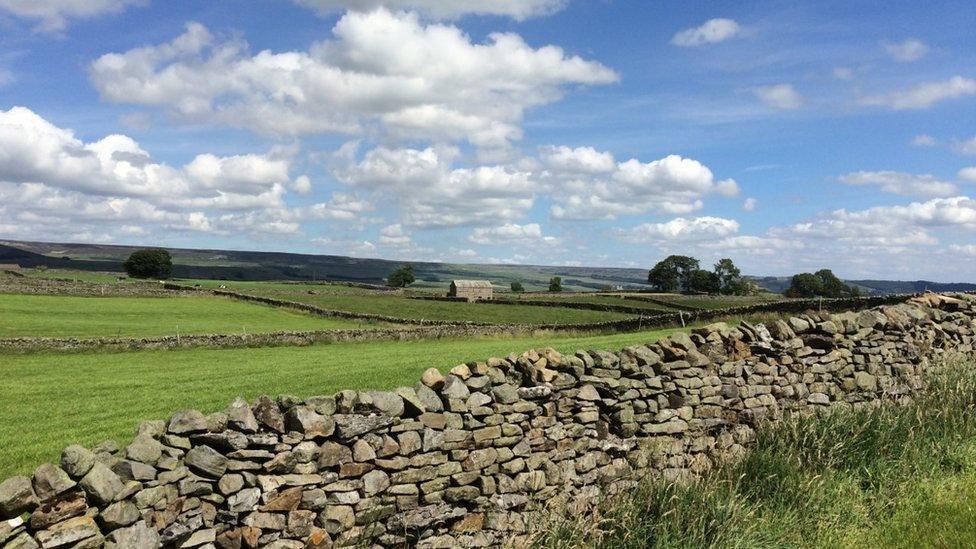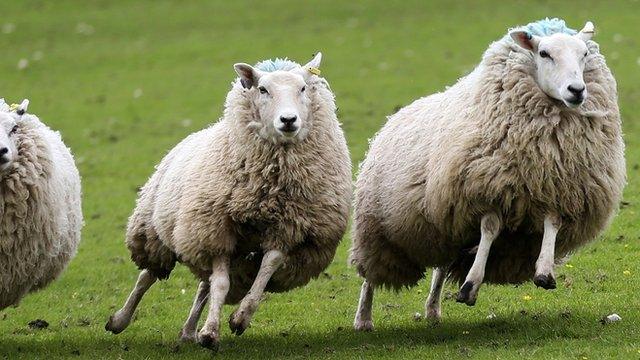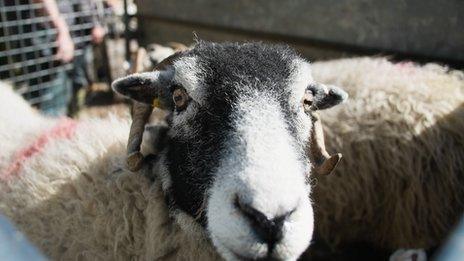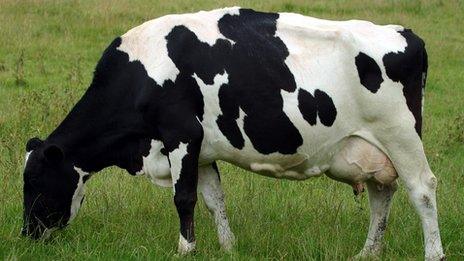Wensleydale police and farmers tackle sheep rustlers
- Published

Gangs are targeting flocks of sheep in the remote parts of the Yorkshire Dales, but police are being trained to identify the animals
Wensleydale in North Yorkshire - a patchwork of green pastures divided by dry stone walls rising to meet moorland, where the heather is bright purple at this time of year.
It is the classic Yorkshire Dales landscape. But all is not right here.
There is one other famous feature of this countryside and they keep disappearing. Sheep rustling is the problem and efforts are being stepped up to tackle it.
On the southern flank of the dale, David Dinsdale calls instructions to his border collie Tom to round up his flock of mule gimmers - young ewes. For miles around, the white dots of other flocks can be seen against a green backdrop.
The purpose of gathering the sheep in is to teach police officers how to spot a stolen animal. Mr Dinsdale has farmed here all his life and remembers a time when there were more police living locally.
Microchipped flocks
He said: "There was the main station at Leyburn. There was a policeman in Bainbridge and another at Hawes.
"We'd see our nearest once a week but now we very rarely see a policeman ride up this back road.
"It's easier for people to get into the area and get stock away."
Improvements in communication technology, along with roads in the area, mean the days of the village bobby here are long gone.
That modernisation thought has also brought hi-tech gadgetry with it.
Mr Dinsdale expertly grabs one of his sheep and shows PC John Wilbor the ear tag on the animal . This has a microchip inside and when scanned with a wand, with which officers are being issued, it indicates the number of the flock it comes from.

Gangs pick on flocks of sheep grazing on the more remote locations across northern England
If police stop a suspicious vehicle, the animals in the trailer can be identified immediately.
Of course, thieves are not stupid and these tags can be quickly removed - so there is also a far more traditional, low-tech means to enable identification.
Mr Dinsdale shows PC Wilbor the Shepherds' Guide - an extraordinary 450 page book which lists the unique markings of every flock in northern England. From fleece markings to horn burns - every flock is distinct.
"If the police know what they're looking for, they have a much better chance of apprehending those responsible," says Mr Dinsdale.
According to insurer NFU Mutual, claims for stolen livestock totalled £6.6m in 2014.
The firm said that equates to the disappearance of 89,000 sheep.
Slaughtered for food
They are all believed to have been slaughtered and the meat then sold in to the food chain.

Sheep are identified with ear tags and the flocks are noted in the Shepherd's Guide book
Officers believe the trail of stolen animals leads to the big northern conurbations about an hour's drive from the dales.
They are working with other organisations to try to track the animals but most sheep are rustled from remote pastures where no-one can see what is happening.
They also only take a few at a time meaning the thefts are not spotted until the sheep are counted - which can be weeks after the crime has been committed.
But, armed with the new and old technology and better training police officers in this part of the country will now be able to stop suspicious vehicles and quickly establish if animals are stolen.
- Published26 August 2015

- Published11 August 2014

- Published22 September 2013
